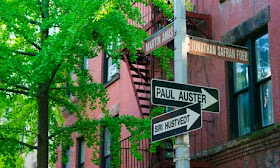¨You could ascribe this shift to the rampant gentrification that has swept across much of Brooklyn, or at least the part of it that lies closest to Manhattan (a recent survey indicated that Brooklyn contained four of the nation's top 25 most rapidly gentrifying neighbourhoods). The response to it has been conflicted. On the one hand no one wants to return to the 1980s, when a neighbourhood such as Red Hook, now home to Ikea, was dubbed by Life magazine the crack capital of America. On the other hand, rising rents and property prices change the character. If he were able to return, Agee would still find Syrians along Atlantic Avenue and Sicilian-speaking Italians in Carroll Gardens. The Polish atmosphere of Greenpoint persists, as do the descendants of the "grizzling skull-capped Jew" Agee encountered on DeKalb Avenue. But here's what else he would find: spiralling rents; waiting-list only restaurants specialising in complex pork dishes; immaculately rendered bars posing as prohibition-era watering holes; and scores of cafés crowded all day long with young men and women staring intently at their laptops while the expensive cappuccino makers hiss and sigh.
Of course writers can and do live anywhere, but the fact that Brooklyn has become, in the words of the New York Observer, "a zone of infestation, not only of novelists but reporters, pundits, poets, and those often closeted scribblers who call themselves editors and agents", is a peculiarity it shares with no other major metropolitan area. When Martin Amis moved to Cobble Hill last year it was widely viewed by the press as an official imprimatur on Brooklyn's status as the writing factory of America. Not that Brooklyn was ever short of writers – Walt Whitman used to edit the Brooklyn Eagle, and Norman Mailer held court in Brooklyn Heights for much of his life, alongside Truman Capote – but the phenomenon is now so pronounced that you could say, without exaggeration, that there are two principal avenues for would-be writers in America. The first is to swallow the exorbitant price tag for one of the country's multiplying creative-writing courses (usually Masters of Fine Arts, or MFAs); the second is to move to Brooklyn.¨
REFERENCE:
Excerpt from the article by Aaron Hicklin

No comments:
Post a Comment